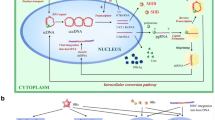Abstract
Primary hepatocellular carcinoma (HCC) is one of the most common cancers occurring in human, and there is strong epidemiological evidence suggesting that persistent hepatitis B virus (HBV) infection is the most important risk factor for its development.HBx gene was found to be a transactivator recently. Its continuous expression in hepatocytes may transactivate cellular genes which can play a certain role in development of HCC. TheHBx gene fragment was used to construct a recombinant eukaryotic expression vector pCEP4 and introduced into HepG2 cells. The effect ofHBx gene on HCC cells growth and its molecular mechanism in HCC cells regulation were investigated.
Similar content being viewed by others
References
Rossner, M. T., Review: hepatitis B virus X-gene product: Apromiscuous transcriptional activator, J. Med. Virol., 1992, 36: 101.
Kim, C. M., Koike, K., Saito, I. et al.,HBx gene of hepatitis B virus induces liver cancer in transgenic mice, Nature, 1991, 351:317.
Benn, J., Schneider, R. J., Hepatitis B virus HBx protein activates Ras-GTP complex formation and establishes a Ras, Raf, MAP kinase signaling cascade, Proc. Natl. Acad. Sci. USA, 1994, 91: 10350.
Kekule, A. S., Lauer, L., Weiss, B. et al., Hepatitis B virus transactivator HBx uses a tumour promoter signalling pathway, Nature, 1993, 361:742.
Benn, J., Su, F., Doria, M. et al., Hepatitis B virus HBx protein induces transcription factor AP-1 by activation of extracellular signal-regulated and c-JunN-terminal, J. Virol., 1996, 70: 4978.
Lin, Y. T., Nomura, J., Cheong, D. et al., Hepatitis B virus X protein is a transcriptional modulator that communicates with transcription factor IIB and the RNApolymerase II subunit 5, J. Biol. Chem., 1997, 272: 7132.
Henkler, F. F., Koshy, R., Hepatitis B virus transcriptional activators: mechanisms and possible role in oncogenesis, J. Viral Hepat., 1996, 3: 109.
Koike, K., Moriya, K., Yotosuyanagi, H. et al., Induction of cell cycle progression by hepatitis B virusHBx gene expression in quiescent mouse fibroblasts, J. Clin. Invest., 1994, 94: 44.
Benn, J., Schneider, R. J., Hepatitis B virus HBx protein deregulates cell cycle checkpoint controls, Proc. Natl. Acad. Sci. USA, 1995, 92: 11215.
Trunat, R., Antunovic, J., Greenblatt, J. et al., Direct interaction of the hepatitis B virus HBx protein with p53 leads to inhibition by HBx of p53 response elemented-directed transactivation, J. Virol., 1995, 69: 1851.
Becker, S. A., Lee, T. H., Butel, J. S. et al., Hepatitis B virus X protein interferes with cellular DNA repair, J. Virol., 1998, 72:266.
Powell-Braxton, L., Hollingshead, P., Warburton, C. et al., IGR-I id required for normal embryonic growth in mice, Genes Dev., 1993, 7:2609.
Baker, J., Liu, J. P., Roberston, E. J. et al., Role of insulin-like growth factors in embryonic and postnatal growth, Cell, 1993, 75: 73.
Kaleko, M., Retter, W. G., Miller, A. D., Overexpression of the human insulin-like growth factor I receptor promotes ligand-dependent neoplastic transformation, Mol. Cell. Biol., 1990, 10: 464.
Pietrzkowski, Z., Sell, C., Lammers, R. et al., The role of insulin-like growth factor I (IGF-I) and the IGF-I receptor in epidermal growth factor-stimulated growth of 3T3 cells, Mol. Cell. Biol., 1992, 12: 3883.
Prager, D., Li, H. L., Asa, S. et al., Dominant negative inhibition of tumorigenesisin vivo by human insulin-like growth factor I receptor mutant, Proc. Natl. Acad. Sci. USA, 1994, 91:2181.
Sell, C., Dumenil, G., Deveaud, C. et al., Effect of a null mutation of the type I IGF receptor gene on growth and transformation of mouse embryo fibroblasts, Mol. Cell. Biol., 1994, 14: 3604.
Resnicoff, M., Coppola, D., Sell, C. et al., Growth inhibition of human melanoma cells in nude mice by antisense strategies to the type I insulin-like growth factor receptor, Cancer Res., 1994, 54: 4848.
Kim, S. O., Park, J. G., Lee, Y. I., Increased expression of the insulin-like growth factor I (IGF-I) receptor gene in hepatocellular carcinoma cell lines: implications of IGF-I receptor gene activation by hepatitis B virus X gene product, Cancer Res., 1996, 56:3831.
Su, Q., Liou, Y. F., Zhang, J. F. et al., Expression of insulin-like growth factor II in hepatitis B, Sirrhosis and hepatocellular carcinoma: its relationship with hepatitis B virus antigen expression, Hepatology, 1994, 20: 788.
Ferrara, N., Davis-Smyth, T., The biology of vascular endothelial growth factor, Endocrine Rev., 1997, 18: 4.
Maeda, K., Chung, Y. S., Ogawa, Y. et al., Prognostic value of vascular endothelial growth factor expression in gastric carcinoma, Cancer, 1996, 77: 858.
Suzuki, K., Hayashi, N., Miyamoto, Y. et al., Expression of vascular permeability factor/vascular endothelial growth factor in human hepatocellular carcinoma, Cancer Res., 1996, 56: 3004.
Harper, J. W., Adami, G. R., Wei, N. et al., The p21CIP1/WAF1 cdk-interacting protein Cip1 is a potent inhibitor of G1 cyclin-dependent kinases, Cell, 1993, 75: 805.
El-deiry, W. S., Tokino, T., Veleulescu, V. E. et al., WAF1, a potential mediator of p53 tumor suppression, Cell, 1993, 75: 817.
Rodrgo, B., Heather, M. B., Existence of two population of cyclin/proliferating cell nuclear antigen during the cell cycle: association with DNA replication sites, J. Cell. Biol., 1987, 105: 1549.
Chen, J., Jackson, P. K., Kirschner, M. W. et al., Separate domains of p21CIP1/WAF1involved in the inhibition of cdk kinase and PCNA, Nature, 1995, 374: 386.
Author information
Authors and Affiliations
Corresponding author
Rights and permissions
About this article
Cite this article
Tao, X., Shen, D., Ren, H. et al. The role of hepatitis B virus × gene in development of primary hepatocellular carcinoma. Sci. China Ser. C.-Life Sci. 43, 293–301 (2000). https://doi.org/10.1007/BF02879289
Received:
Issue Date:
DOI: https://doi.org/10.1007/BF02879289




